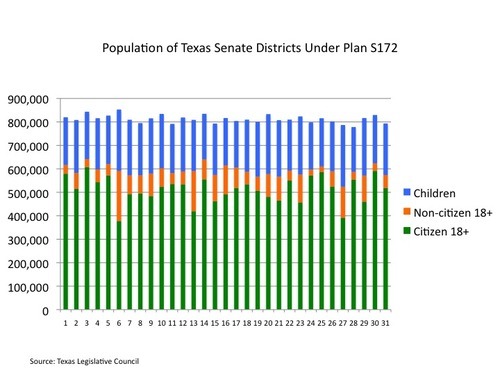From Texas Redistricting:
[Monday] morning, two Texas voters filed a suit in federal court challenging the state senate map drawn by the Texas Legislature on the grounds that it violated the equal protection guarantees of the Fourteenth Amendment by using total population rather eligible voters to draw districts.
The plaintiffs in the case are backed by the Project for Fair Representation, which also helped back Shelby County’s challenge to section 5 of the Voting Rights Act as well as efforts to overturn affirmative action policies at the University of Texas at Austin.
The Center’s press release announcing the new Texas suit can be found here.
More information here.
What’s at issue?
The plaintiffs argue that the current Texas senate map (Plan S172) must be redrawn using “eligible voters” rather than “total population” – the measure long used by the Texas Legislature – because the latter now results in districts with significantly differing numbers of voters.
By not using eligible voters, the plaintiffs say the Texas Legislature violated the “one-person, one vote” principle of the Constitution’s Fourteenth Amendment by allowing some voters’ votes to count for more than those of others.
Why are there disparities?
In Texas, the major driver of disparities in the number of eligible voters is the high number of non-citizens in parts of the state – mainly its urban and suburban cores. For example, in places like Dallas and Houston, commonly accepted estimates are that around half of adult Hispanics are non-citizens.
Of course, disparities also can exist for any number of other reasons, including higher numbers of children under 18 in fast growing parts of the state or a larger number of people who are unable to vote because of felony convictions.
However, differing citizenship rates are, by far, the largest driver of disparities in the number of eligible voters.
[…]
How would drawing districts using “eligible voters” change the current map?
At present, Texas senate districts have a target population of 811,147 people.
If courts were to require maps to be drawn using some measure of eligible voters, the target size of districts also would change.
For example, although Texas has over 25 million people, its citizen voting age population in the most recent Census Bureau report was estimated to be just 15,583,540. Using CVAP to draw districts would mean that each district would have a CVAP target of 502,695.
That target population would require significant reworking of districts that presently have large Hispanic populations.
In the Houston area, for example, SD-13, represented by State Sen. Rodney Ellis, has a CVAP population of only 419,035, and SD-6, represented by State Sen. Sylvia Garcia, fares even worse with just 377,505 citizens of voting age. Likewise, in the Dallas area, SD-23, represented by State Sen. Royce West, has just 456,955.
Even with permitted deviations from the target population, these districts would need to add population, mostly likely by drawing from neighboring Anglo-dominated districts. Though those people might or might not be Anglo, the need to add large numbers of people mean the demographics and electoral performance of the districts could change materially. In fact, the need to add people might very well jeopardize the protected status that those districts currently enjoy under section 2 of the Voting Rights Act.
In other words, this could be a very big deal not only for Hispanics but also potentially African-Americans.
There could be practical impacts as well for legislators since urban districts would likely end up with far greater numbers of total people – who, although they might not be able to vote, still have need for constituent services – and be much larger physically as well.
Wasn’t there a similar case recently about the same issue?
Yes. In fact, it involved many of the same players.
In Lepak v. City of Irving, the lawyers in the Texas senate case – also backed by the Project for Fair Representation – represented Irving residents in arguing that the city’s new single-member council district map was unconstitutional because it had been drawn using total population rather than CVAP.
Both the district court and the Fifth Circuit ruled against the Irving plaintiffs, citing the Fifth Circuit’s ruling in Chen v. City of Houston, which held that the question of whether to use total population or CVAP was a political question and thus not reviewable by courts.
The Irving plaintiffs sought to have the decision reviewed by the Supreme Court, but the high court declined last April to take the case.
However, the Texas senate case potentially represents another opportunity to have the Supreme Court take up the issue since any appeal would go directly to the Supreme Court as a matter of right.
More background on Lepak here.
There’s more at the link, but basically this is a nuisance action being brought by some professional grievance-mongers. It would serve them right not only to have the case dismissed with prejudice, but also to be assessed full court costs and attorneys’ fees for wasting everyone’s time. The Observer and Rick Hasen have more.

